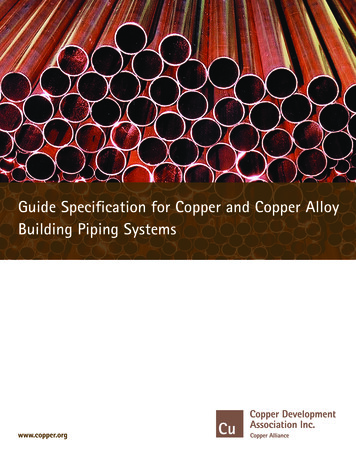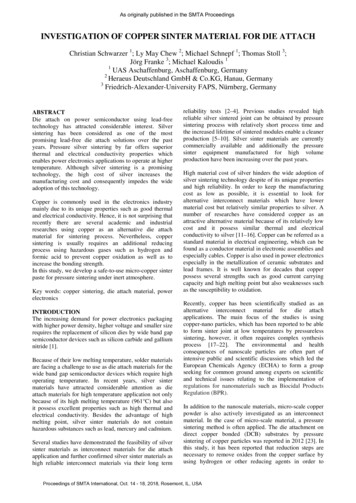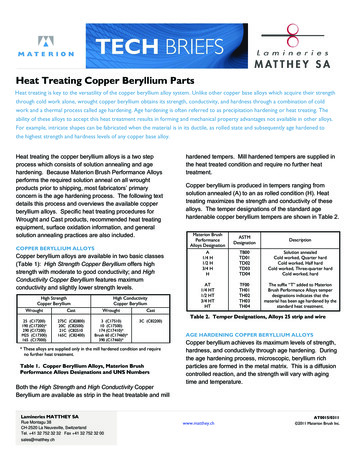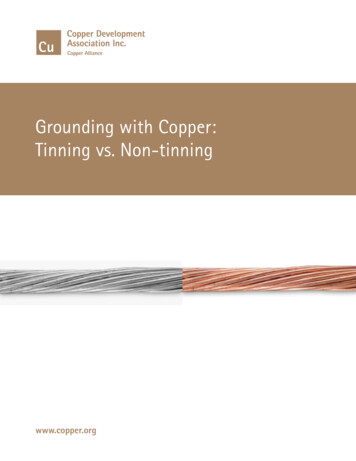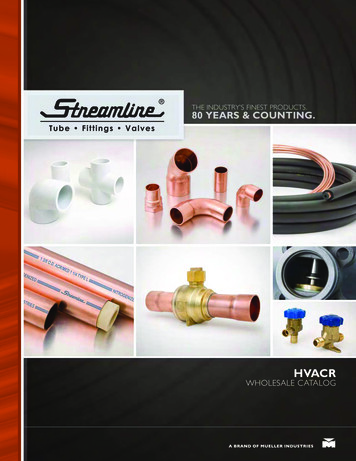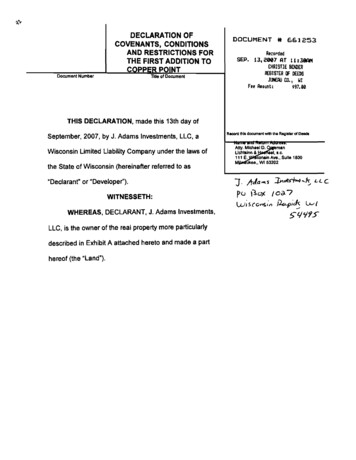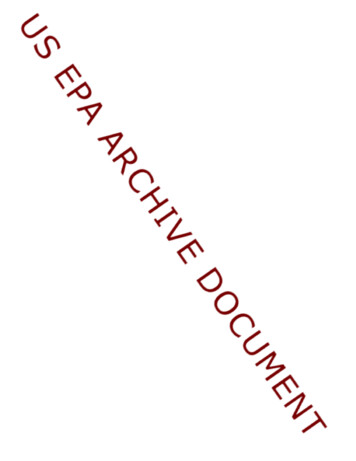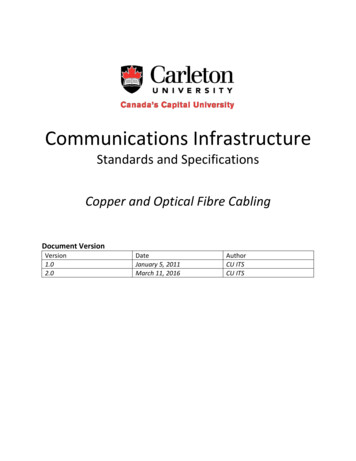
Transcription
Communications InfrastructureStandards and SpecificationsCopper and Optical Fibre CablingDocument VersionVersion1.02.0DateJanuary 5, 2011March 11, 2016AuthorCU ITSCU ITS
Table of Contents12345INTRODUCTION . 41.1Purpose . 41.2Scope . 41.3Accountability and Management. 41.4Requesting and Purchasing CU ITS Cabling Products and Services . 51.5Implementation . 5STANDARDS. 62.1Conformity to Relevant Standards . 62.2Approved Manufacturer Certified Solutions & Products . 72.3Cabling Standard - Structured Cabling System (SCS) . 72.4Installation Company Quality Assurance . 72.5Application Assurance and Warranty . 72.6General Cabling Installation Standards and Workmanship . 82.7Installation Staff Standards and Accreditation . 9GUIDELINES . 103.1Types of Use . 103.2Design Guidelines. 10TELECOMMUNICATION ROOM (TR). 124.1General. 124.2Data Services . 144.3Voice Service . 144.4Access . 144.5Lighting . 144.6Air conditioning . 154.7Racks . 154.8Grounding and Bonding . 154.9Power . 164.10Patch Panels . 164.11Cable Management . 174.12Cable Trays . 174.13Miscellaneous . 18CAMPUS BACKBONE CABLING SYSTEM . 185.1General. 185.2Underground Installations . 192 Page
5.3Outdoor Above Ground Installations . 195.4Cabling Pathways . 195.5Optical Fibre . 195.6Optical Fibre Terminations. 205.7Voice Grade Cabling . 206BUILDING BACKBONE CABLING SYSTEM. 206.1General. 206.2Voice Grade Cabling . 216.3Overvoltage . 216.4Cabling Pathways . 217HORIZONTAL CABLING . 217.1General. 217.2Cabling Pathways . 227.3Cable Terminations - Inter-Connect System . 237.4Work Area . 237.4.1Telecommunication Outlets (TO) . 237.4.2Flush Mounted Faceplates . 248LABELLING AND NUMBERING . 259COMPLIANCE TESTING . 2610DOCUMENTATION . 2710.1General. 2710.2Work Area . 2710.3Test Result Documentation. 271111.1CUSTOMER ACCEPTANCE. 27General. 2712APPENDIX A. Example Communications Rack Layouts . 2913APPENDIX B. CARD ACCESS/CBORD CABLING CONTROLLER DEMARC . 3014APPENDIX C. LIST OF MATERIALS . 3115DEFINITION OF TERMS . 3616ABBREVIATIONS . 383 Page
1 INTRODUCTION1.1 PurposeThis standard provides the minimum installation and operational requirements for CarletonUniversity (CU) cabling systems. This standard applies to all Carleton University Computingand Communications (CU ITS) copper and fibre cabling (voice and data), in horizontalcabling, and backbone cabling. The standard is to be applied to all copper and fibre opticalcabling within all Carleton University campus and buildings, regardless of their intended use.1.2 ScopeThe principles of the standard must be applied when conducting cabling projects ormove/add/change (MAC) for: The construction of new buildings. Renovation of existing buildings. Upgrade to existing cabling infrastructure. Implementation of cabling infrastructure to interconnect new or existing buildings. Existing and/or addition of connections for end point devices.1.3 Accountability and ManagementThis standard outlines effective and consistent management of cabling throughout allCarleton University buildings.All parties (CU ITS, Cabling Contractor, Clients and others) must ensure that: All cabling work conducted is consistent with regulatory and legislative obligationsincluding relevant Canadian Standards. All relevant stakeholders are consulted prior to commencing cabling projects. Comprehensive audits are conducted on completion of cabling projects. Only cabling systems offering appropriate are used. Warranty documentation for cabling infrastructure is kept up to date and that copiesare provided to CU ITS.Any conflicting information should be clarified with CU ITS. Any conflicting informationshould be governed by reference to the following documents: Relevant Canadian Standards. Relevant Industry Standards. Relevant Network standard. Internal instructions by CU ITS.4 Page
1.4 Requesting and Purchasing CU ITS Cabling Products and ServicesThis standard requires that all requests and purchases comply with Carleton Universitystandards.All parties must ensure that: Where cabling is purchased as part of a major building project, contracts betweenCarleton University and the cabling contractor/vendor are formed in compliance withCarleton University Purchasing Services Policies. This standard is referenced as requirements in tender and contract documentation. Cabling contractor/vendor must be a CommScope Systimax Solution Partner andCormant-CS (CableSolve) Business Solution Partner or Master Dealer LicensedDistributor. Unless there are issues that cannot be addressed, cabling works should be assignedto the preferred cabling contractor/vendor that was selected through the regular(every 5 years) Request for Proposal (RFP) process. All MAC work orders must go through ITS Service Desk ticketing system.1.5 ImplementationThe University employs a Structured Cabling System which shall consist of a flexible cablinginfrastructure to support computer, telephone, video and other IP based communicationssystems (e.g. WIFI, Building Automation, Security), independent of their manufacturer. Thestructured cabling infrastructure has, at the workstation, a telecommunications outlet that iswired to a central point using star topology, providing flexibility for University personnel.The requirements of the Structured Cabling System described in this document apply to allnew cabling installations on all buildings of Carleton University. These guidelines also applyto the refurbishment of existing installations or any Moves, Adds or Changes (MAC’s) toexisting installations.The Structured Cabling Solution shall use CommScope Systimax unshielded Category 6components, Singlemode OS2, and Multimode OM3, and OM4 optical fibre.The solution should define the method(s) of flexible patching for the telecommunicationsservices to enable simple MAC’s without frequent rewiring of locations.All communications cabling works done at Carleton University shall be managed by CU ITSwith an exception in areas where specific department have an agreement with CU ITS thatthey will be responsible in the management of cabling infrastructure for the platform orenvironment that they are supporting. A good example for this is Card Access/CBORDcontroller environment. 1Any works which do not adhere to the guidelines contained in this document will be deemednoncompliant, and will be rectified by the contractor responsible for the works at thecontractor’s expense.1APPENDIX B, CARD ACCESS/CBORD CABLING CONTROLLER DEMARC5 Page
This document will change to reflect current industry standards and CU ITS requirements,and as such will be subject to version changes as required.It is the responsibility of the contractor to ensure that they have the latest version of the CUCommunications Infrastructure Standards and Specifications document.2 STANDARDS2.1 Conformity to Relevant StandardsAll Structured Cabling work shall be installed in strict compliance with the CarletonUniversity’s Communications Cabling Infrastructure specifications, to the latest standardslisted below and the latest applicable CommScope Enterprise Solutions (Systimax NetworkInfrastructure) warranty specification f).Carleton University’s Communications Cabling Infrastructure specifications take precedenceover such standards and the applicable CommScope Enterprise Solutions specification. Therelevant Canadian Standards take precedence over any international standard unlessotherwise specified in this document. All cabling and connection equipment and materialssupplied shall be products that are approved by the manufacturer.The latest versions of the following standards and specifications are to be complied withunless otherwise specified in this document. In all cases, where there is a discrepancy orclarification is required between this document and the following standards andspecifications, clarification and approval in writing from CU ITS shall be obtained prior tosubmission of tender. No variation will be allowed after tender submission. 6 PageANSI/TIA-568.D-1, Commercial Building Telecommunications InfrastructureStandardANSI/TIA-568-C.2, Balanced Twisted Pair Telecommunications Cabling andComponents StandardANSI/TIA-568-C.3, Optical Fiber Cabling ComponentsANSI/TIA-569-C, Commercial Building Standard for TelecommunicationsPathways and SpacesANSI/TIA-606-B, Administration Standard for the TelecommunicationsInfrastructure of Commercial BuildingsANSI/TIA-607-B, Generic Telecommunication Grounding and Bonding forCustomer PremisesANSI/TIA-598-C, Colour Coding of Fiber Optic CablesANSI/TIA/EIA-942, CommScope Telecommunications Infrastructure Standard forData CentersANSI/NECA/BICSI-568, Standard for Installing Commercial BuildingTelecommunications CablingANSI/TIA-758-B, Customer-Owned Outside Plant TelecommunicationsInfrastructure StandardANSI/TIA-526-7, Measurement of Optical Power Loss of Installed Single-ModeFiber Cable PlantSystimax PowerSUM and GigaSPEED XL Cabling Design Guidelines
CommScope Enterprise Data Center Design GuideBICSI Guidelines and Installation PracticesTDMM: CommScope Telecommunications Distribution Methods Manual 13thedition2.2 Approved Manufacturer Certified Solutions & ProductsCommScope Systimax Solution Copper (e.g. Category 6) and Optical Fibre Products andSolutions shall be used in all Carleton University buildings. “Equivalent” products are notacceptable.22.3 Cabling Standard - Structured Cabling System (SCS)The Structured Cabling Solution shall be designed and installed to provide the CommScopeSystimax Telecommunications infrastructure (patch panels, frames, patch leads, cables,faceplate and outlets) necessary to build a uniform premises distribution system, which willfunction for a multimedia communications solution to support minimum 1000Mbps (1Gigabit Ethernet).The solution shall be designed and installed to enable flexible point to point patching of theTelecommunications services to allow for simple Moves, Adds & Changes, (MAC’s) withoutfrequent rewiring of locations.All of the products supplied into installations must be new and not reused products. All ofthe specified manufacturer’s products supplied shall be genuine.The communications channel shall be capable of supporting the provision of power to theData Terminal Equipment as specified in the latest IEEE 802.3at “Power over Ethernet”standard.2.4 Installation Company Quality AssuranceThe installation company shall have a quality system in place that conforms to therequirements set out in the ANSI-TIA standards and the installation company shall providedetails of certification with CommScope.The installation company shall install, terminate, test and commission the cablinginfrastructure to the relevant industry standards and the manufacturer’s standard unlessapproved in writing by CU ITS.2.5Application Assurance and WarrantyAll installations of telecommunications infrastructure in new or existing Carleton Universitypremises require CommScope Systimax SCS 20-year Extended Product Warranty andApplication Assurance, and shall be provided by the nominated manufacturer for warrantyfrom the date of successful completion of testing and commissioning of the StructuredCabling System.2APPENDIX C. LIST OF MATERIALS - CommScope Systimax Solutions7 Page
The application assurance shall cover the failure of the offered cabling system to operate theapplications that the system was initially designed to support, namely those identified in thecurrent (at the time of tendering) versions of the Cabling Performance Specifications (that isthe ANSI TIA set of standards.For any specifications not mentioned in this document, please refer to the latest appropriateCanadian/BICSI/ANSI/TIA and Vendor specific direction to conform to the correctspecifications and certifications. The CU ITS is to be notified of these instances prior to anyaction being taken associated with these.2.6 General Cabling Installation Standards and WorkmanshipAll cables shall be run and installed in a professional manner, in accordance to the latestpublished COMMSCOPE Systimax CAT 6 Installation Guidelines. It contains the appropriateand collective requirements of these standards and is therefore the mandated minimumrequirements for cabling products, installation and compliance testing.The cabling system shall be planned and designed to ensure adequate segregation fromelectrical and hazardous services, ensuring system integrity and performance, ensuring thatit does not present problems of current and future maintenance or access, and ensuringthere is no conflict with the operation and maintenance of other systems. The installer shallseal all openings, either external or internal, made or provided through building walls, floors,ceilings or other fixtures after the cable has been reticulated to ensure the integrity of thebarrier that has been penetrated. This includes but is not limited to the ingress of moisture,entry of rodents and other vermin and fire where applicable. All exposed cabling shall bemechanically protected to ensure protection from external forces.The installation company shall be responsible for providing corrosion resistant products usedin the installation of the structured cabling system and must ensure that any future corrosionof these products is limited. The installer is also responsible for the restoration of anydamaged paintwork on equipment or accessories and this restoration must meet the originalfinish. If any damage occurs during the installation it must be reported to the CU ITSimmediately.All communications equipment installed within Carleton University campus shall be installedin such a way that it is aesthetically pleasing and is in conformity to the equipmentsurrounding it. All exposed materials shall be consistent and shall not conflict with thesurrounding décor.The Contractor shall take responsibility for ensuring that after the work being carried out, thebuildings / grounds / work areas are returned to its original state, as not to draw attention tothe work that has been done i.e. installing the same duct work already existing in the area,painting, back filling, laying turf, etc.The Contractor shall check the surface finishes and paintwork around the area of installationand touch-up or repair/replace all damaged parts after the installation of cabling andequipment.8 Page
The Contractor shall provide literature including data on maintenance and operation of allequipment installed. Relevant catalogues of all materials, instruments, equipment, andcomponents, to be supplied shall be provided CU ITS electronically.All installed equipment and materials shall be permanently and legibly marked to indicateclearly the name of the manufacturer’s registered trademark.Any existing data cabling affected by the relocation of the communication outlets is to bereinstated. All old cabling is to be totally removed by removing all cabling from the walloutlet to the network patch panel terminations in the cabinet/communications room.Any cabling infrastructure found by the Cabling Contractor to be non-conforming to ITSguidelines, the manufacturer’s guidelines, or Canadian Standards, while doing work on thephysical layer network, shall be reported to CU ITS. A recommendation for rectification ofthe non-compliance should be included as part of the report.2.7 Installation Staff Standards and AccreditationThe Cabling Contractor and nominated personnel must all hold current relevant andnecessary licences/open registration with appropriate endorsements, and must presentthese prior to commencement of work.The Contractor shall provide a technical support staff member holding a current, and validBICSI RCDD certification.The successful Contractor shall supply a list of names of installation staff and a copy of theiraccreditation certificates from the specified manufacturer. This requirement does not applyto apprentices or trainees under the full-time supervision of an authorised installer of thespecified manufacturer. A minimum of 50% of the installation staff on site at any timethroughout the installation must be certified by the specified cabling manufacturer.Carleton ITS reserves the right to inspect, and validate the certification requirementsspecified in this document.The Contractor shall provide a list of their technical support staff listing their workingexperience in the relevant field.The Contractor shall state the nearest location of their principal support centre. This centreshall have permanently stationed support staff capable of providing technical supporteffectively and efficiently when requested by CU ITS.Contractors are required to undertake Carleton University site inductions for each site beforecommencing work on that site.Contractors working on sites must attend Workplace Health & safety induction, includingasbestos training. Contractors must adhere to facilities safety plan procedures and forwardappropriate documentation as required under this.9 Page
Contractors on sites must be uniformed, with company identification, clearly showing whothey are and what company they are employed by.3 GUIDELINES3.1 Types of UseThe Structured Cabling System shall be capable of supporting current and future services thatrequire, minimum, 300 MHz signalling as specified by ISO/IEC 11801 Class E.These include but are not limited to the following services: IEEE 802.3 (Ethernet) IEEE 802.11 (Wireless LAN) Building Security and Access Analogue Telephone Digital Telephone Facsimile EFTPOS Building Management Systems Security Cameras Modems Digital and Analogue video Composite baseband video and audio Broadband Video RGB baseband video 3D Imaging Digital and Analogue Audio3.2 Design GuidelinesThe Structured Cabling System is designed to support a high speed, high availability andredundant network that allows for future growth and capacity increase.All cabling infrastructure is to be installed by vendor certified installers, to the level as set outby this document. All cabling infrastructure is to be installed and tested to vendorcertification.Each building shall be provided with:Backbone Cabling Infrastructure Optical Fibre services via diverse paths and building entry points. Backbone Optical Fibre to be terminated at the fibre patch panel in the BuildingDistributor (BD). Backbone cable Infrastructure shall be terminated in the BD.10 P a g e
Telecommunications Rooms (TR)A minimum of one TR per floor shall be provided; the number and size of TRs per floorshall be governed by 90 meter maximum cable run length and the size of the floor space. Cabinets to be at least 44 RU 800mm x 900mm with 900mm space at front, back andsides of racks or rack assembly as per Canadian standards. Each cabinet to be supplied at minimum with 2 x 20A circuits for power, each ontheir own separate dedicated circuit. Power and HVAC infrastructure shall have sufficient capacity to provide adequatepower load and maintain requisite (or appropriate) temperature control - i.e. 23degrees, ANSI/TIA. Room to be permanently locked and keyed as per the standard CU ITScommunications room keys.Cable Risers and Pathways Cable risers and pathways to be independent from all other services. Main cable pathways shall be cable tray or steel wire basket form. Shall allow for 50% spare capacity for future growth. Shall be fire rated where the cabling traverses’ floors or fire rated buildinginfrastructure as required by relevant codes. Cable pathways above solid or feature ceilings to be cable tray with appropriateaccess panels to be installed for future access.Horizontal Cabling and Telecommunication Outlets Horizontal cabling to be an unshielded structured cabling system, at least Category 6,with RJ45 outlets at each end. Horizontal cabling to be no more 90 meters from patch panel to wall outlettermination. Telecommunication outlets at new workstations are to be at least four connectorfaceplates, with two cables on each. Ceiling mounted outlets and in-ceiling telecommunication outlets for wireless accesspoints are to be positioned as per the CU ITS direction, and standards. Cabling for wireless will have their runs terminated with a ceiling mounted or inceiling telecommunication outlet secured to a permanent structural member.Labelling of cabling infrastructure Labelling as per CU Cabling Specifications document section 8 of this document.Test results, Documentation and Record Books Test results and as-built drawings for all cabling infrastructure to be provided oncompletion of works to CU ITS in the form set out by the Cabling Specificationsdocument, section 10 “Documentation”.Acceptance and handover11 P a g e
It is a requirement that all works adhere to the above guidelines and to specificsoutlined in the cabling specification document in order for acceptance, handover,and any associated payments for works to take place.Acceptance of BD/FD to include the cleaning of the communications room floor,inside the cabinets and frames and wipe down of cabinets, racks and associatedinfrastructure, so as to prevent the ingress of building dust in active networkequipment once installed.4 TELECOMMUNICATION ROOM (TR)4.1 GeneralThe Telecommunications rooms are comprised of Campus Distributors (CD), BuildingDistributors (BD), and Floor Distributors (FD), all are interconnected, and in turn connect toData centers. The communications rooms shall be able to contain: Telecommunications equipment Horizontal and vertical cable terminations Associated inter-connecting cables.The Campus Distributor (CD) is defined as the space that houses equipment whichconnect all buildings and Data Centers together in a meshed network architecture.The CD is a connection point between all BDs. Carleton currently deploys four (4) CDs(PoP rooms).The Building Distributor (BD) is defined as the space that acts as the transition point betweenthe outside plant backbone and the vertical distribution pathways in a building; that is, itforms the backbone/building interface.Building Distributor (BD) covers space dedicated to providing telecommunication andnetworking services inside buildings.The BD is used to terminate the campus cabling, building backbone cabling, horizontalcabling, as well as house network equipment in order to allow data and voice services to beprovided for the work area in a structured cabling system.The BD may contain telecommunications equipment and other communications equipmentsuch as CATV, IPTV, CCTV, Security, Fire Alarm, Lighting Control, Public Address and Audio.The BD may also contain small UPS equipment, and other Building Automation Service (BAS)equipment. Only electrical equipment servicing BD/FD shall be located inside the room.The layout of the equipment racks, voice frames and other equipment & services within theBD shall be approved
ANSI/TIA-568.D-1, Commercial Building Telecommunications Infrastructure Standard ANSI/TIA-568-C.2, Balanced Twisted Pair Telecommunications Cabling and Components Standard ANSI/TIA-568-C.3, Optical Fiber Cabling Components ANSI/TIA-569-C, Commercial Building Standard for Telecommunications Pathways and Spaces
